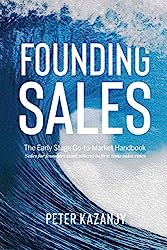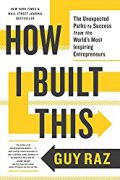
Rating: 8.5/10.
Founding Sales: The Early Stage Go-to-Market Handbook by Peter Kazanjy
Book about how to do sales from first principles, for the founder of a startup who has never done sales before. The approach to startup sales is different from that of a bigger company, and you should do work that doesn’t scale. Firstly, adopt the sales mindset of moving quickly and having an “abundance mentality”, where there are many potential customers you haven’t contacted yet; try to maintain lots of shallow relationships and move quickly. Statistically, most of the time your sale will fail, but you should treat each sale as if it is inevitable until you receive a clear rejection. Keep track of customer information and metrics using CRM software.
Start by crafting a narrative (which will serve as your sales pitch later): tell a story about the problem, and a customer who is experiencing it. Explain how the problem is costing them a lot of money and why the current solution is inadequate. Then, describe your solution and how it works at a high level. Emphasize the value your solution brings compared to its price, therefore it is a great investment. In the beginning, lean towards charging a lower price to make the sale easier, but avoid giving it away for free, but don’t set the price too high as to impact your win rate.
Prepare your sales materials: a slide deck and scripts for cold emails and demos. Good idea to have a master copy of the slide deck that salespeople can use and branch off to customize for different clients. Customization is important for both the slides and any emails you send: always tailor your materials to the specific needs of each client, rather than relying on a generic or hypothetical case, focus on what they need and skip over irrelevant details so you will have slightly different versions of the materials for different clients. Invest in creating marketing materials, like videos, which are useful for sales teams since they can be incorporated into demos and shared with clients.
Prospecting phase: the most important task is to qualify clients and don’t waste time on unqualified leads: stop engaging with customers who lack the budget or have no need for your product. Establish a few criteria that can quickly help you qualify or disqualify prospects, using publicly available information. Check what technology they use, what positions they have open, who are their customer base, and how big they are, how big is the company overall, etc. Initially, it’s good to focus on medium-large sized accounts within your local area, as selling face-to-face is easier than selling over Zoom. Use LinkedIn to gather public information, as it provides the most up-to-date information compared to other sources, don’t buy contact lists as they tend to be outdated. Tools can help you discover people’s emails based on their name and organization, these tools work by generating combinations of first and last names and checking which ones are valid.
After you’ve gathered a list of prospects, now it’s time to email and call them. At the beginning founders should handle this personally instead of outsourcing it to a sales professional because sales professionals are good at scaling a proven pitch and product but not usually good at constructing one from scratch. The goal of the email or call is to convince prospects to commit to a demo. Often they want to end the conversation quickly, and there are various tactics you can use to prevent them from hanging up, and listen to you for 30 seconds and perhaps leading to a demo. Sometimes there is a gatekeeper who controls access to the decision-maker, in which case, you need to persuade the gatekeeper to transfer you to the superior and convince them that it’s a valuable use of their time. Leverage your LinkedIn network to get warm contacts at other companies, which is better than cold calls since there is already some level of trust.
Set up a system to capture inbound leads. This is basically a form to capture information when someone hears about your product through word of mouth, but with inbound leads, it’s important to filter out the unqualified ones to avoid wasting time. The advantage of inbound leads is that these prospects are already excited about your product, but they might not truly have a need and budget for your product. Therefore, ask for basic information and qualification questions, including their phone number. Respond quickly to qualified leads, ideally within five minutes of them filling out the form, as it’s fresh on their minds. Providing a phone number is useful since many professionals prefer talking rather than typing out a lengthy email.
Now it’s time for the pitch and demo. Allocate at least 15 minutes to review the client’s account and needs. Start the meeting with a few minutes of smalltalk, and then ask discovery questions to understand the customer’s pain points, even if you have already done this during qualification, it’s good to verify their needs again and stop the meeting if they are unqualified. During the demo, present slowly and ask clarifying questions to ensure they understand the key points, repeat the main points several times present a customized demo to their specific problems, this is better than offering hypothetical scenarios or irrelevant features. At the end of the demo, ask for the sale and provide several different proposal options for them to choose from, and expect some objections. Prepare answers to common objections such as not needing the product or budget constraints; often, objections have underlying meanings, so need to understand the underlying problems and address those instead of focusing on surface-level words. If they don’t think they need the product but your intel indicates otherwise, emphasize the value your product provides and how it outweighs the costs.
After the demo, expect some negotiation before reaching a verbal agreement and sending a contract. To ensure nothing falls through the cracks, keep a pipeline with various stages and track each customer’s progress and duration in each stage to track if any customers have been stuck in a stage for an unusually long time. Prioritize the highest-value customers closest to the sale as they are closest to generating revenue. Once you have mastered this process yourself, consider hiring a junior sales rep to handle prospecting and setting up demos. Also, your job doesn’t end once the sale is made, it is equally important to ensure that customers are getting value from your product, or else they will churn when it’s time for renewal. Make sure they are set up properly and know how to use it: schedule training sessions (best individual instead of group). Make it easy for customers to reach out to you in case they run into any problems. Keep key decision-makers in your customers’ companies updated on business metrics and new software features, so it will be easy to for them to renew for another year.
The last few chapters are on a later stage, when the sales process has been proven multiple times and it’s time to scale up. It’s crucial for the founder to do the sale a few dozen times before hiring sales people to make sure it’s repeatable. Once the founder becomes overwhelmed with sales work, they can delegate responsibilities to others: typically, a Sales Development Representative (SDR) is responsible for prospecting and scheduling demos, an Account Executive (AE) handles selling after the demo, and a Customer Success Manager (CSM) takes charge of customer relationships after the sale. To expand further, after these three subdivisions, you can increase the number of employees in each role and add respective managers. As the sales organization grows, you will need to track metrics and performance reviews to keep everyone on track, and managers need to monitor and intervene if performance is subpar. Eventually, more processes, clear metrics, and a professional career path should be developed.
When hiring for sales, look for persistence, intelligence, positive attitude, and attention to detail. It’s ideal to hire salespeople who have previously sold to similar decision-makers at similar price points, not necessarily experience in the same software category. Conduct quick phone screens to filter out most candidates, so that valuable on-site interview time can be spent on the most promising ones. During interviews, have them pitch a product and look at how they send emails. Compensation should be based on performance, which motivates salespeople to make additional emails and calls, but set reasonably achievable targets or else they will become demotivated. During the onboarding process, ensure that salespeople have all the necessary equipment and provide training on the tools they are expected to use. Make sure they understand the product they are selling, customer problems, and business model before they begin contacting customers. Conduct practice calls, either by mock calls with colleagues or by having more senior salespeople shadow them.
Overall, this book is well-suited for startup founders who don’t have a sales background and is learning it for the first time. It takes the reader through the entire process, starting from first principles. I found it helpful to include numerous scripts for various email and calls, and guidelines for how each email should be crafted, including initial calls, follow-up emails, scheduling demos, etc, and will be useful for adapting them to sell your own product.



